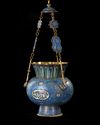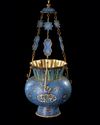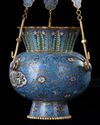Lot 202 A CHINESE CLOISONNÉ MOSQUE LAMP FOR THE ISLAMIC MARKET, LATE 19TH CENTURY
A Cloisonne mosque lamp with a compressed globular body standing on a spreading foot with lobbed mouth, decorated with a white-ground panel enclosing an Arabic inscription of Kalimaat al-Tawhid, further stylised in coloured enamels with scrolling lotus and flower-heads, all on a light-blue ground.
Height: 25.5 cm.
Diameter: 24 cm.
Total height: 67.5 cm.
CATALOGUE NOTE
As early as the 9th century, a large number of products were made in China for export to the Islamic world. Porcelain and textiles were the most important trade goods, but refined works of art in other materials could also be sold, especially if they were furnished with Arabic inscriptions. This lamp, which was probably made for a local Chinese-Muslim clientele, illustrates a fascinating mixture of traditional Chinese and Muslim craft traditions. While the form and script can be related directly to the mosque lamps of the Arab world, the style of the decoration, with lotus patterns, is characteristically Han Chinese. The cloisonné enamel technique was evidently already known in China in the late Yuan period (13th-14th century), but developed in earnest under the succeeding dynasties. In this technique, glass paste of various colors is placed within pattern-shaping enclosures (cloisons) in metal objects, usually copper or bronze. The decorated object is then fired until the glass melts, after which the surface is polished until it is smooth and even.





